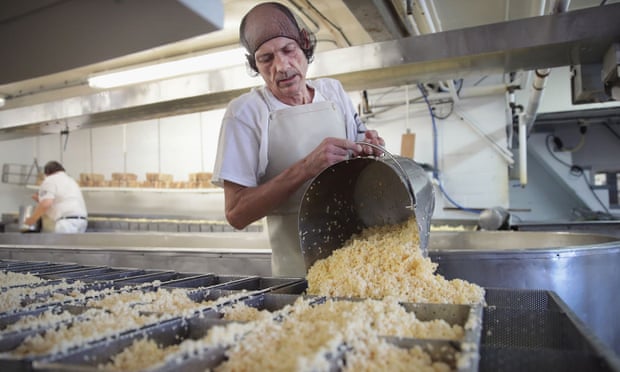
Say cheese, America. No, seriously, please start saying cheese at the grocery store. The country’s dairy farmers are depending on you.
Americans eat an awful lot of cheese: almost 37lb per person, per year. Yet apparently that’s still not enough. Demand for American-made cheese is seriously falling behind supply. According to recent data from the Department of Agriculture, we’re currently experiencing a 1.4bn-pound cheese surplus.
Lucas Fuess, director of dairy market intelligence at HighGround Dairy, a consulting firm, explains that cheese is literally sitting in cold storage facilities waiting for some aspiring pizza-maker to give it a home.
“It’s normal to have some cheese in warehouses, to make sure there’s enough in the pipeline,” Fuess said. “The amount that’s in there currently is, if not a record, very close to record high.”
Advertisement
In part this can be linked to lower dairy consumption and the growing popularity of veganism. Plant-based products such as almond-milk have experienced rapid sales growth.
Since 2008, milk production has surged by 13%, but domestic demand for milk has dropped sharply. As demand decreases, the price of milk drops, and farmers receive less per gallon produced. This appears to have pushed farmers to produce even more milk to make up the shortfalls in their income, exacerbating the problem.
Producing American cheese helps farmers to use up milk they can’t sell and that would otherwise go off. At the end of November 2018, US cheese production had grown yet again for the 67th consecutive month.
But the problem is Americans are eating less cheese, too.
American diets are moving away from processed cheeses like Velveeta and Kraft, and many of the nation’s leading fast and casual restaurants are trying new things. Panera, like others, has replaced American cheese in their sandwiches with a four-cheese combo made up of fontina, cheddar, monteau and smoked gouda.
According to Euromonitor International, sales of processed cheese are projected to drop 1.6% this year, the fourth year in a row.
In part, that’s because many Americans now think processed cheese is gross, but also because they’re au fait with quality cheese from around the world. It’s hard to turn back to an indestructible fluorescent orange mess once you’ve tried brie de meaux.
“We’re seeing increased sales of more exotic, specialty, European-style cheeses. Some of those are made in the US; a lot of them aren’t,” Andrew Novakovic, a professor of agricultural economics at Cornell University told NPR this week. Since imported cheese costs more than domestic, a few blocks of the good stuff might not leave much left in the old cheese budget for anything else.
The cheese mountain is crushing farmers. “We’ve seen record numbers of dairy farms close because milk prices are so low that dairy farms aren’t profitable any more,” Feueff added. “This cheese that is hanging over the market is preventing prices from raising higher and it’s reaching a critical level.”
Trump’s trade policy has also played a role in the cheesepocalypse. In response to his tariffs, three top importers of US milk and cheese products – Mexico, Canada and China – have instituted retaliatory tariffs that will have a significant impact on American dairy farmers’ bottom line, according to a study from Texas A&M University.
“As long as the tariffs are still on in Mexico, it remains a challenge to move cheese out of the country and move those stocks lower,” Fuess explained.
It’s not the end of the line. Analysts have noted large buyers of cheese increasing offerings or finding new ways to use it. McDonald’s recently launched a breakfast sandwich with two slices of American cheese. “Fast-food companies are taking this opportunity with low cheese prices to increase cheese on their dishes,” says Fuess.
For now though, American dairy farmers are going to continue to look for ways to offload their cheese supplies. “I was just reading stories of cheese tea in China that have kind of gone viral,” Fuess said. “Maybe we need to look into that.”























